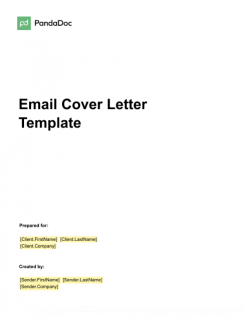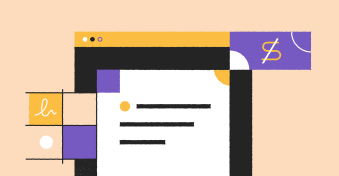Knowing how to create a cover letter that is attention-grabbing can make or break a job application, so it’s vital that you get it right.
What is the difference between a CV and a cover letter?
The difference between a CV and a cover letter is presenting the facts of your employment and education vs introducing yourself to an employer/human resources team/hiring manager in a more personal light.
What does a cover letter include?
A good cover letter should include your professional experience, motivation for applying, and examples of skills, achievements, and qualifications relevant to the job opening, providing an opportunity to stand out from the crowd
In fact, in a survey from last year, 83% of hiring decision-makers said an effective cover letter could lead to an interview even if a CV was less impressive.
So, how can you write a unique and professional cover letter that will impress that 83% and increase your chances of success?
Read on for examples, PandaDoc templates, and our best seven-step guide for how to construct a cover letter that will boost your employability.
Tips on writing an effective cover letter
Recruiters are busy people; you should anticipate that they’ll be reading a lot of generic cover letters, especially if you’re applying for a lucrative position. Grab their interest right away by following our guide, which includes:
- The best way to write a cover letter and stand out among your competitors.
- Tips on how to draft a cover to boost your chances of landing the job of your dreams.
- Actionable ideas on how to start and end your cover letter, plus what to put in the cover letter’s middle part.
- Cover letter templates to use for the body of your cover letter to get you more interviews.
PandaDoc can help you with writing a cover letter thanks to our 167+ cover letter templates, which will make your process much easier.
Just pick the template for your industry, and enjoy the beauty of effortless cover letter creation.
Succeed at writing a cover letter with our seven-step guide
Follow this straightforward seven-step guide to check off everything that should be included in a cover letter.
Step 1. Start with a professional header
Every professional cover letter header should include the following:
- Your full name
- Your phone number
- Your email address
- The date
- The hiring manager’s name and professional title
- The company name and its address
You can also choose to add:
- Your professional title
- Your home address
- Your city of residence
- Your social media accounts (applicable for LinkedIn and Twitter only)
- Links to your professional websites
Although a more casual tone and formatting have been adopted for cover letters over recent years, it’s still important to submit a professional cover letter.
For that reason make sure to:
- Send your cover letter from a respectful address; sexydaddy@gmail.com or coolgirl123@hotmail.com won’t work.
- Use an email address from a recognized provider — either Gmail or your domain if you have one.
- Don’t send your CV and cover letter from your current work address. It’s disrespectful to both your current and potential employer.
- Ensure your resume, cover letter, and social media profiles share contact information that is consistent and accurate.
Step 2. Include a standout greeting/salutation
The greeting/salutation is one of the essential parts of the first paragraph of a cover letter as this is the very first thing your hiring manager sees.
A foolproof strategy to make your cover letter greeting catch their attention is to start like so:
‘Dear John,’’
That’s right. Although it may seem less polished, when we see something addressed to us personally, we react with positive recognition. In addition, the hiring manager scanning your letter will feel like they are reading something personal, tailored specifically for them, and respond positively to whatever’s written next.
Good examples of cover letter greetings:
- Dear Hanna,
- Dear Miss McGee,
- Dear Ms. Wright,
- Dear Mrs. Johnson,
- Dear Mr. Davis,
- Dear Hiring Manager
- Dear PandaDoc Sales Team Hiring Manager
- Dear PandaDoc Team
- To whom it may concern
Step 3. Write a noteworthy opening paragraph
No matter how hard you’ve worked to create your cover letter, unless you make a great first impression and grab the hiring manager’s attention with the introduction, your information will probably end up in the trash.
Let’s take a quick look at an example of writing a good cover letter introduction as well as a bad one:
Bad
In response to your posting for the Senior Java Developer on your website, I would like to express my interest for the position. As a Java Developer with 5+ years of experience, I believe I would succeed in this role. Why is this the wrong way to go about an opening statement? Honestly? It provides zero value.
The way this paragraph reads is, “I’ve been doing this job for 5+ years already, so I think I’d be good at it.” Is that what hiring managers are looking for? Hardly.
Now, here’s what a cover letter opening should sound like:
Good
As an admirer of PandaDoc and its product, I was thrilled to see your posting for a senior developer position. I have 5+ years of experience successfully leading 10+ teams online and live. In addition, I have succeeded at expanding XYZ’s client base by 21% since 2015. I am positive I am the right person to hire for this position. Why? Because I’ll work smart to help you overcome our company’s upcoming challenges and make our product even more stellar (if that’s even possible).
The HM’s likely response:
“Wow, this person already feels like a part of the team!”
Let’s reiterate: the main reason your cover letter opening must be effective and different is so you have the chance to show how well you know your prospective employer’s needs, highlight your short-term and long-term achievements, or express your enthusiasm for potentially joining their company.
Step 4. Follow with a middle paragraph
So, what should a cover letter look like once you’ve mastered the introduction?
The second or middle paragraph is the section where you can explain why you are the perfect person for the position.
But, as explained in the paragraph above, you are not going to impress anyone by telling them you’ve already done the job they are recruiting for.
Once you’ve got the hiring manager’s attention with your superb cover letter introduction and they’ve reached the middle paragraph, you have the chance to shine and offer them precisely what they are looking for.
How? By showing that you’ve got what it takes to satisfy the company’s specific needs.
Say the company you are applying for needs:
- Social media management skills (1)
- Someone to organize and supervise the content team of freelance writers for their new portal (2)
Let’s see how to make a cover letter paragraph that demonstrates you are both (1) and (2):
In my current position at XYZ, I have initially developed, then supervised a strategy and its application across all of our social media platforms (1). A year ago, my key responsibility was to organize teams of 10+ graphic designers, both in-house and online, develop strategies that would help them stay on top of the tasks, and ensure everyone stays on the deadline without jeopardizing the quality delivered.
The results we’ve achieved a year later:
- Seven of the nine social media profiles I’ve developed strategies for have gained client recognition and a success rate of 87%.
- Our team of graphic designers has expanded to 25, with no resigns and my task strategy still in use (2).
Voila! But, this is where you draw the line. You don’t want them to think you are bragging. Instead, you’ve clearly communicated your results in the middle paragraph, and it’s now up to them to decide how to proceed.
Step 5. Finish with a proper closing paragraph
You’ve done everything well so far, and now you are at the finish line where nothing could go wrong, right? Nope!
The closing paragraph of your cover letter is a decisive part, and you have to be really smart about it. This is the paragraph that should make the hiring manager excited to start reading your CV or resume.
The best cover letter ending is one that provides value. Tell the hiring manager you are excited about meeting in person and discussing ways your experience and knowledge fit into their company culture and how you can contribute to your future employer’s company growth.
Here’s a good cover letter example for a closing paragraph:
I would appreciate the chance to discuss your objectives in person and show you how my results and success at XYZ can translate into your company’s growth.
Step 6. Add the postscript
Let’s never underestimate the power of a well-crafted post scriptum, especially not when writing a cover letter! While the above-listed sections are all must-haves of an effective cover letter format, the postscript (i.e., P.S.)can give a cover letter unique flair.
For some reason, hiring managers are drawn to post scriptum like a magnet, so use this to your benefit. Whether you are sharing something exciting about your career or just saying that you’d be happy to provide more information about yourself, it’s up to you.
See this postscript cover letter example:
P.S. — I would greatly appreciate the opportunity to show you how my social media strategy helped grow our ROI by a record-breaking 15% in a single year. I’m available to provide more information at a time convenient to you.
Step 7. End with a professional sign-off
A professional sign-off is like the cherry on top of a super delicious cake – the thing that ties it all together.
Add “Sincerely” at the bottom of your cover letter and follow it with your full name. A handwritten signature is recommended if you are sending out a more formal cover letter, however, an e-signature can now also be used for most applications.
If you’d rather go with something else, here are some sample cover letter closing options that would still be safe bets:
- Best regards
- Kind regards
- Thank you
- With best regards
Some additional sign off options are:
- Regards
- Yours truly
- Sincerely yours
- Respectfully yours
- Thank you for your consideration
- Have a great day
Whether you are sending your cover letter to a corporation or a more casual business, any of these closing greetings are suitable.
Need help writing a cover letter or filling out a job application form? Go to PandaDoc to streamline your recruitment processes and create job application forms quickly and easily with PandaDoc’s suite of document creation tools.
Reviewing your cover letter
Before sending your cover letter, review and proofread it to make sure the application you’ve worked so hard on doesn’t end up in the bin due to something banal, like an omitted comma or some weird formatting.
Here are a few things to watch out for:
- A cover letter is typically single-spaced and uses either US Letter (USA) or A4 (Europe and elsewhere) page size. Use a standard font like Arial or Calibri, and keep the font size between 10.5 and 12 points.
- Adjust your cover letter margins between 1″ and .5″ on each side to make it readable and easy on the eyes.
- Left-align all cover letter content except for your own contact details, which can be centered.
- Check your cover letter grammar by filtering all content through a trusted spell-check tool or giving it to an expert to proofread.
How long should a professional cover letter be?
A professional cover letter should typically be between 200 and 350 words, but this can vary depending on how much you want to communicate. Just don’t make it too short or turn it into a book, and you should be fine.
Things to avoid when writing a good cover letter
To avoid coming across as unprofessional, remove the following from any cover letter for a job application:
- Personal information: Religion, family, sexual orientation, gender, and similar information.
- Photos: Whether a professional headshot or a selfie, photos are no longer welcome on CVs or cover letters.*
- Salary information: Salary expectations, former salary, etc.
- Questions and inquiries: Job expectations, questions about company benefits, company culture, etc. Leave all questions for the interview process.
- Information copy-pasted from your CV: Instead of copy-pasting skills lists or bullet point sentences from your CV, reference that information in a new way and expand on it.
*If you are applying for a position where your physical appearance matters (i.e., modeling and such), your employer is allowed to ask for photos with the resume and cover letter.
Writing a cover letter for IT: Do’s and don’ts
An IT cover letter is normally structured slightly differently than regular cover letters.
The reason is simple – IT experts are often tasked with explaining complex ideas to those with significantly less understanding or knowledge of the topic.
Therefore, the cover letter must show you can conduct complex projects and share knowledge with your peers.
So, what should be included in a cover letter for IT? Here’s a helpful list of Do’s and Don’ts:
IT cover letter do’s
- Keep it one page, with the ideal length between 250 – 350 words (approx. four paragraphs).
- Detail your relevant technical skills and proficiencies to make them easily comparable to the job posting requirements.
- Emphasize the other qualities desirable from an IT employer’s perspective.
- List all start-up work and/or side projects you’re working on.
- Underline your aptitude for constantly learning and improving your skills.
- Show how passionate you are for the IT industry overall and why.
IT cover letter don’ts
- Don’t exaggerate your level of competency or experience.
- Stay away from company-specific terminology; use what is known and understood at an industry level
- Don’t highlight your technical skills only; emphasize your communication and people-based skills, too.
In essence, a perfect IT cover letter should provide a balanced view of your high-level technical experience and your ability to collaborate with various colleagues, clients, and stakeholders.
Five cover letter myths you should stop believing immediately
In the sea of cover letter (mis)information, it’s sometimes hard to determine what is correct information that can be relied on.
We expose five most common cover letter myths that you should abandon completely:
Myth 1. No one reads cover letters anymore
False!
In fact, in situations where an HR department is evaluating equal candidates, the cover letter may just decide who gets the interview!
While most hiring managers/recruiters don’t look at a cover letter immediately upon receiving it, they will read it if your resume rings with them.
Myth 2. Cover letters should summarize your resume
The purpose of a cover letter isn’t to summarize your skills and expertise but emphasize your eagerness (not desperation!) to get the job.
It gives you a window to tell your employer how committed and passionate you are about your career, why you’d be the right candidate for them, and how your background and mindset can assist their company’s future success.
Myth 3. It’s okay to send your resume without a cover letter
Unless the job posting you are applying for explicitly says not to send a cover letter – always send it!
A cover letter is an addition to your resume and a way for the employer to see you’ve put a little extra effort into trying to get the interview.
Myth 4. A cover letter is your chance to talk about your feelings
Nuh-huh! Your resume isn’t there to talk about your personal life in any way; it’s there to talk to your employer about them and how they can benefit from the marvelous assets you offer.
While you can describe unique traits that set you above other applicants, don’t get too personal.
Myth 5. After you send a letter, the ball is in the employer’s court
Most employers are super busy people who don’t have the time to hunt you down unless they need you right away.
If you don’t hear from them, it’s fine to call or e-mail to confirm that your resume and cover letter have been received.
Final thoughts
When considering how to write a cover letter for a job application, the most important thing to bear in mind is the time, thought, and effort you put into it.
You won’t write your best cover letter between meetings or on your lunch break.
Follow the advice listed above, and start writing your cover letter today. And, if you need help, PandaDoc is just a click away!
Disclaimer
PandDoc is not a law firm, or a substitute for an attorney or law firm. This page is not intended to and does not provide legal advice. Should you have legal questions on the validity of e-signatures or digital signatures and the enforceability thereof, please consult with an attorney or law firm. Use of PandaDocs services are governed by our Terms of Use and Privacy Policy.
Originally published October 12, 2021, updated February 22, 2024



